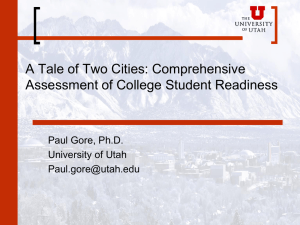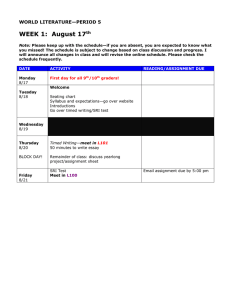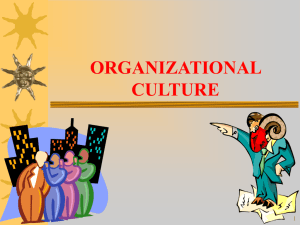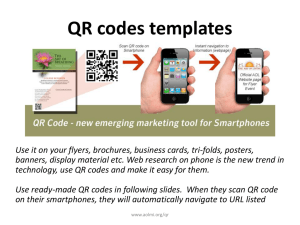What Works in Promoting Student Success Steve Robbins ACT, Inc.
advertisement
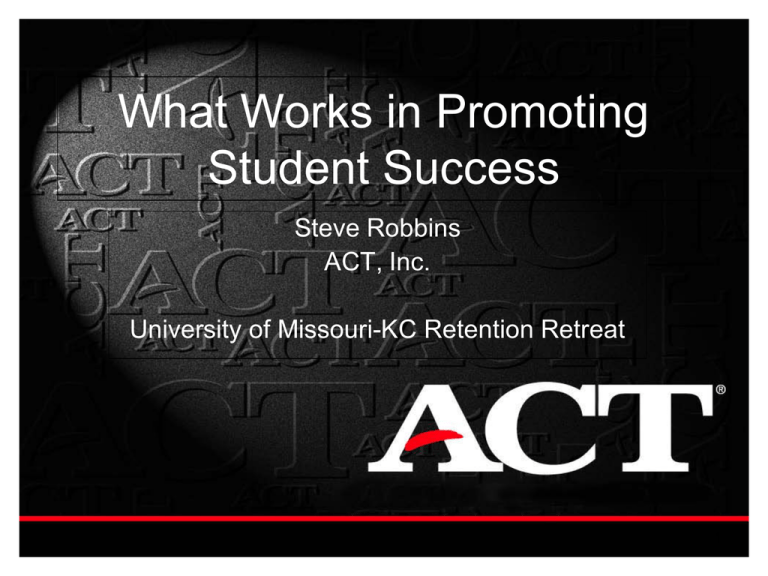
What Works in Promoting Student Success Steve Robbins ACT, Inc. University of Missouri-KC Retention Retreat 1 Overview • • • • Why College Students Stay What Works in Promoting Student Success The Importance of an Early Warning System A Model for Institution-wide Assessment and Intervention • A Model for Effective Placement and Intervention with Developmental Students • Putting It All Together 2 Harris, S. (1991) Can’t you guys read? Cartoons on Academia. Rutgers University Press. New Brunswick, NJ, p.74 3 Why College Students Stay Four-Year College Students: • First-year GPA has large effects on the likelihood of retention and transfer. • Motivation (Academic Discipline) and precollegiate academic preparation have indirect effects on retention and transfer by working through first-year GPA. 4 Why College Students Stay (cont) • Social connection has a direct effect on retention. • SES predictive of transfer behavior: – Higher SES students transfer while poor students give up. – African-American students have high commitment but difficulty with classes resulting in higher drop-out rates. See Robbins et al. (2006); Allen et al. (2008) 5 Harvard Business Review. (July-August 2007) 6 Meta-Analysis and Validity Generalization as Key Tools • Summarizing the effect of something over multiple data points • Create confidence intervals of the true effect size • Interpretation of multiple studies is better than any individual study 7 Testing Integrated Meta-Analytic Path Analysis Motivation/ Skills Intervention Self -Regulation Performance Persistence Social Engagement The Effects of College Interventions on College Outcomes as Mediated by PSF’s 8 Robbins et al. (2009) Categorizing College Interventions • Orientation (21 hours) – summer, early fall, time-limited • Freshman Year Experience (45 hours) • Academic (8 hours) – Study skills – Learning strategies – Note-taking • Self-Management (6 hours) – Stress management – Self-control – Anxiety management • Hybrid of Academic & Self-Management (12 hours) 9 Categorizing Psychosocial Factors (PSFs) Three Categories • Motivation: – Academic Discipline – Commitment to College • Self-Regulation: – Steadiness – Academic Self-Confidence • Social Engagement: – Social Connection – Social Activity Robbins, S., Allen, J., Casillas, A., Peterson, C., & Le, H. (2006) Robbins, et al. (2004) 10 A Summary of Findings • Interventions with an academic focus are key • Boost academic interventions using self management strategies, i.e., Hybrid • Align specific interventions to narrowed outcomes (PSF and/or success) to increase treatment effect 11 A Summary of Findings (cont) • Rethink the goals & the focus of Freshman Year Experience • Understand mediating role of motivation and self-regulation factors to promote student success 12 Giving Guidance Herzog & Miller (1985) 13 Using the Student Readiness Inventory (SRI) as an Early Warning System Met our criterion of being grounded in research: – Reviewed meta-analysis of 109 studies that examined predictors of academic performance and retention Met our criterion of considering the whole student: – Motivation, self-regulation, and social engagement coupled with academic preparation factors – Factors are amenable to change 14 Using the Student Readiness Inventory (SRI) as an Early Warning System Able to: – Administer at orientation and have for early in the semester – Create an early warning system for targeted intervention – Aid support of previously identified “at-risk” groups – Create a cross walk of scales to our services and use within our existing framework of services including • Academic coursework for freshmen • Student Affairs programs and services • Academic advising 15 Development of the Student Readiness Inventory Motivation and Skills – – – – – – Commitment to College Goal Striving Academic Discipline General Determination Study Skills Communication Skills Social Engagement – Social Activity – Social Connection Self-Management – Academic Self-Confidence – Steadiness Robbins et al. (2004) 16 SRI Scale Definitions & Sample Items SRI Scale Definition Sample Item Academic Discipline The amount of effort a student puts into schoolwork and the degree to which a student is hardworking and conscientious. I consistently do my school work well. Academic Self-Confidence The belief in one's ability to perform well in school. I achieve little for the amount of time I spend studying. Commitment to College One's commitment to staying in college and getting a degree. A college education will help me achieve my goals. Communication Skills Attentiveness to others' feelings and flexibility in resolving conflicts with others. I'm willing to compromise when resolving a conflict. General Determination The extent to which one strives to follow through on commitments and obligations. It is important for me to finish what I start. Goal Striving The strength of one's efforts to achieve objectives and end goals. I bounce back after facing disappointment or failure. Social Activity One's comfort in meeting and interacting with other people. I avoid activities that require meeting new people. Social Connection One's feelings of connection and involvement with the college community. I feel part of this college. Steadiness One's responses to and management of strong feelings. I have a bad temper. Study Skills The extent to which students believe they know how to assess an academic problem, organize a solution, and successfully complete academic assignments. I summarize important information in diagrams, tables, or lists. Sample SRI Profiles • Class of 2007 college students completed the SRI at the beginning of their 1st semester (Fall 2003) • Sample profiles selected to contrast academic preparation and motivation Motivation ACT score 18 Low High Low Student A Student B High Student C Student D Low ACT score (composite = 14) Student A LOW ACT Scale Student B LOW MOTIVATION HIGH MOTIVATION Percentile Percentile 0 10 20 30 40 50 60 70 80 90 100 0 6 95 General Determination 17 72 Goal Striving 13 80 9 51 Study Skills 47 59 Communication Skills 34 99 Social Connection 76 49 Social Activity 9 83 Academic Self-Confidence 2 46 Steadiness 6 71 Academic Discipline Commitment to College Low SRI Indices Outcome 19 Medium High 10 20 Low 30 40 50 60 70 Medium 80 90 100 High Academic = 1 Academic = 20 Retention = 3 Retention = 17 1st-year GPA = 1.5 1st-year GPA = 2.22 Fall 07 status = dropped out Fall 07 status = still enrolled High ACT score (composite = 27) Student C HIGH ACT Scale Student D HIGH MOTIVATION LOW MOTIVATION Percentile Percentile 0 10 20 30 40 50 60 70 80 90 0 100 3 92 55 50 4 26 Commitment to College 22 22 Study Skills 31 38 Communication Skills 46 12 7 45 Social Activity 15 57 Academic Self-Confidence 32 92 9 53 Academic Discipline General Determination Goal Striving Social Connection Steadiness Low SRI Indices Outcome 20 Medium High 10 Low 20 30 40 50 60 70 Medium 80 90 High Academic = 60 Academic = 96 Retention = 50 Retention = 88 1st-year GPA = 3.7 1st-year GPA = 4.0 Fall 07 status = dropped out Fall 07 status = graduated 100 Two Case Examples: 1. Targeting at-risk students and coordinating interventions across all segments of the university 2. Developmental classes in college 21 Case I: Northern Arizona • Public university • 4-year institution with 800 faculty serving 22,000 students • 13,000 undergraduate students on the Flagstaff campus • ~30% dropout rate after freshman year • Implemented a card swiping system to monitor resource use • Required the SRI and created a smorgasbord of systematic interventions for at-risk students Robbins et al. (2008) 22 Strategic Intervention Model: What We Wanted • Implement early in the first semester • Include groups known to be at risk • Collaborate and not duplicate 1. Academic advising and first year programs 2. Native American Student Services outreach program 3. Summer bridge program and first year mentoring 4. Student Support Services, a TRIO program 5. Any key groups interfacing with new freshmen 23 Strategic Intervention Model: What We Wanted (cont) • Be systematic • Address the whole student • Rely on a framework grounded in research 24 SRI Work Group Creating a Network of Academic and Social Resources • VP identified a group of staff to spearhead effort • Group planned and administered instrument over the summer 25 SRI Work Group (cont) • Group identified: 1. Target populations (risk categories) 2. Services linked to needs 3. Other campus collaborator – Freshman year seminar/experience – First year advising center 4. A process for: – – – – 26 Assigning students to most appropriate offices Making appointments with students Notification and outreach Follow up expectations Program Model Assigning Students & Distributing Profiles • • • • 27 Student Affairs Programs and Services Academic Advising Center for Freshmen Freshman Year Experience 101 Freshman Skills-Based Course, EPS 101 Prioritizing Student Groups in Student Affairs “Waterfall” Approach: Assessing Risk & Targeting Students to Be Seen by Each Office • Summer Bridge Program (Ethnic Minority, First Gen, Low Income) • Native American Students (Native American Student Services) • Other Ethnic Minorities (Multicultural Student Center) 28 Prioritizing Student Groups in Student Affairs (cont) • Other First Generation/Low Income (SSS/Learning Assistance Centers) • Living Off Campus (Learning Assistance Centers) • Other Low Scoring (Advising and FYE/EPS) (less than 50th percentile on either index) 29 Student Groups & University Departments No SRI 11% Ethnic Minority 7% STUDENT AFFAIRS Summer Bridge 5% Ethnic Minority Students Native American 3% Invalid / Incomplete 10% 1st Gen & Low Income 6% 1st Gen and Low Income 4% Learning Community 4% African American 2% General Advising Center 21% Skills Class 5% Low Scores Advising Center 9% 30 FYE Class 15% –Multicultural Student Center –Native Amer. Student Services –Student Life (African American) First Generation/Low Income Students –Student Support Services –Learning Assistance Centers Learning Communities/Res Life FIRST YEAR ADVISING CENTER FRESHMAN YEAR PROGRAMS –FYE course –Skills-based course COORDINATING OFFICES –Dean of Students –Assessment Office One-on-One Meetings in Student Affairs Reaching Out and Intervening: A Systematic Outreach • Assign students to programs/office according to service populations • Look up student schedules and set appointment times 31 One-on-One Meetings in Student Affairs (cont) • Send postcard home with appointment time • Send postcard to campus address with appointment time 1. 2. 3. 4. 5. 32 Personal e-mail with appointment time Appointment time/date placed on student’s web calendar Reminder phone call 1-2 days before appointment Facebook contacts and text reminders If miss scheduled meeting, protocol for rescheduling at least two more times. Meeting Purpose • Above all else, connect with student. • Acknowledge the student’s strengths and identify campus activities to reinforce them. 33 Meeting Purpose (cont) • Match the student’s needs to campus resources. 1. Website: home.nau.edu/emsa/sri.asp 2. Tool Shop: act.org/sri/studentguide/toolshop.html • Gather some data on SRI experience. 1. How did you hear about your appointment? 2. How seriously did you take the SRI when you completed it at orientation? 34 Evaluating the Effects of Meeting and Other Resource Use Academic and Persistence Outcomes 35 2007 Retention in 2008 Group Total All -- All NAU FYR (w/o International and Unknown) Retained % Retained 2848 884 1964 69% 652 208 444 68% Targeted and Not Met 427 163 264 62% Non - Targeted Students 1357 349 1008 74% Invalid or No SRI 412 164 248 60% Targeted and Met 36 Not Retained 2007 Retention in 2008 Not Retained Group Total % Retained 102 35 67 66% Targeted and Met 54 14 40 74% Targeted and Not Met 23 9 14 61% Non -Targeted Students 2 1 1 Invalid or No SRI 23 11 12 African American 37 Retained --All NAU FYR --52% 2007 Retention in 2008 Group Total Retained % Retained 316 109 207 66% Targeted and Met 175 50 125 71% Targeted and Not Met 88 37 51 58% Non - Targeted Students 9 2 7 Invalid or No SRI 44 20 24 Hispanic -- All NAU FYR 38 Not Retained --55% 2007 Retention in 2008 Group Total Retained % Retained 2208 654 1554 70% Targeted and Met 301 98 203 67% Targeted and Not Met 258 92 166 64% Non -Targeted Students 1340 345 995 74% Invalid or No SRI 309 119 190 61% White --All NAU FYR 39 Not Retained First Semester Academic Probation for fall 2007 & fall 2008 100% Met Not Met 80% 60% 32% 40% 20% 19% 25% 18% 0% 2007 40 2008 Conclusions Based on Assessment • • Non-targeted students that were expected to do well did (74% retained one year later). Is this number acceptable to UM-KC? Targeted students who met fared better than similarly at-risk students who declined to meet. 1. GPA /Academic Probation 2. Retention • 41 There is room for growth within all categories. Additional Research Findings and Projects Service Utilization – Academic – Social – Recreational – Academic referrals (advising center) – Advising/Career sessions (advising center) 2008 Robbins et al study 42 Resource & Services Utilization Resource/ Service Category Ret. GPA Ret. GPA Ret. GPA Academic Services .75 2.75 .79 2.92 .70 2.63 Recreational Resources .77 2.87 .77 2.76 .71 2.67 Social Resources .72 2.83 .85 2.91 .69 2.63 Academic Referrals -- -- .88 2.95 .60 2.53 .84 2.67 .79 2.83 .57 2.68 Advisory / Career Sessions Level of Utilization High Moderate Low Robbins et al. (2008) 43 Association of Risk Level & Academic Service Use on Retention & 1st-year GPA Risk Level Service Use Moderate Low Ret. GPA Ret. GPA Ret. GPA 0 use .61 2.11 .72 2.58 .77 3.14 1 – 3 Sessions .72 2.41 .77 2.81 .84 3.38 4+ Sessions .62 2.35 .81 2.81 .85 3.22 Gains show interaction on GPA 44 High Summary Points • Intervene early and strategically • Designate a visible individual to coordinate • Collaborate and use natural fits with existing resources • Conduct systematic analysis • Use your data/feedback and improve the process • Maximize utility of the instrument • Go beyond the limits of the instrument 45 Summary Points Continued: Ensuring Student Success • Academic preparation & performance are at the hub • Be clear on goals Satisfaction, learning, & persistence are not the same • Be strategic in your use of resources • Move the mountain to the students Don’t be afraid of intrusive advising 46 A Model for Wilbur Wright College Illinois Innovations in Education Awardee for 2009 47 Before course registration Beginning of course During a course College Developmental Course Best Practices 1. New Student a. Administer COMPASS & SRI1 b. Supportive review & re-test policy2 Non-developmental courses Developmental 2. Developmental Student a. Administer diagnostics1 b. Assess non-cognitive factors for risk2 3. Developmental Instruction a. Instruction tied to diagnostics2 b. SRI practice & use2 2 3 4 Student Data / Characteristics College Responses / Services / Instructional Resources Student Effort / Involvement / Investment College Records a. Effort of students in class3 b. Students’ non-class service use3 a. Academic support b. Non-academic 5. Post-Test End of course 1 During a course 4. Monitoring Status Superscript Legend a. b. c. d. Diagnostics1 Placement1 Grades4 Course completion4 6. Next Course a. Grades4 b. Course completion4 Success in Developmental Courses Dependent on Academic and Psychosocial Risk Success Rates in English Composition, by Academic and Psychosocial (SRI) Risk Levels SRI Risk Level Academic Risk Level 49 High Medium Low High 23% 40% 44% Medium 32% 47% 58% Low 53% 68% 78% Success in Developmental Courses Dependent on Academic and Psychosocial Risk (cont.) Success Rates in Elementary Algebra, by Academic and Psychosocial (SRI) Risk Levels SRI Risk Level Academic Risk Level 50 High Medium Low High 15% 28% 27% Medium 32% 41% 52% Low 50% 67% 69% We Observe the Effects of In-class Student Behavior on Success Success Rates in Elementary (precredit) Math, by COMPASS Pretest and Behavior Rating Levels Behavior Rating Level COMPASS Pretest Scores 51 High Medium Low High 92% 77% 59% Medium 91% 62% 17% Low 69% 44% 6% We Observe the Effects of In-class Student Behavior on Success (cont.) Mean COMPASS Posttest Scores for Elementary (precredit) Math, by COMPASS Pretest and Behavior Rating Levels Behavior Rating Level COMPASS Pretest Scores 52 High Medium Low High 57.4 48.8 45.9 Medium 43.5 38.3 34.1 Low 39.8 33.9 32.6 We Observe the Effects of In-class Student Behavior on Success (cont.) Mean COMPASS Gain Scores for Elementary (precredit) Math, by COMPASS Pretest and Behavior Rating Levels Behavior Rating Level COMPASS Pretest Scores 53 High Medium Low High 19.5 8.9 8.7 Medium 15.7 11.4 6.2 Low 19.7 14.0 12.0 The 3 Pillars of Success Academic Readiness Motivation Instructional Effectiveness • Appropriately place and diagnose • Address motivational skill and engagement behaviors within and outside classroom • Connect instruction to the diagnostic and curriculum targets essential to academic achievement domain (e.g., Math, English) 54 Wrap-Up and Questions for You? • Do you have a systematic way of assessing student risk? • How coordinated are your services? • Have Faculty “bought-in”? • Do you monitor the Return on Investment (ROI) of your central and college based resources? • Are you meeting your retention goals? • Are you meeting your time to degree attainment goals? 55 References ACT, Inc. (2008). What We Know about College Success: Using ACT Data to Inform Educational Issues. Iowa City, IA: Authors. ACT, Inc. (2007). State of College Readiness for Latino Students. Iowa City, IA: Authors. ACT, Inc. & The National Council for Community and Educational Partnerships. (2007). Using EXPLORE® and PLAN® data to evaluate GEAR UP programs. Iowa City, IA: Authors. ACT, Inc. (2004). Schools Involving Parents in Early Postsecondary Planning. Iowa City, IA: Authors. ACT, Inc. (2002). Creating Seamless Educational Transitions for Urban African American and Hispanic Students. Iowa City, IA: Authors. Allen, J., Robbins, S., Casillas,A., & Oh, I.-S. (2008). Why college students stay: Using academic performance, motivation, and social engagement constructs to predict third-year college retention and transfer. Research in Higher Education Braxton, J., Sullivan, A., & Johnson, R. (1997). Appraising Tinto’s theory of college student departure. In J. C. Smart (Ed.) Higher Education: Handbook of Theory and Research, 12, 107-158. New York: Agathon. Bucheri, C., Hampton, T., & Voelker, V. (eds.) (1991). The Student Body: Great Cartoons from the Kappan. Phi Beta Kappa. Bloomington, IN. 56 References (cont.) DesJardins, S. L., Kim, D. O, & Rzonca, C. S. (2002-2003). A nested analysis of factors affecting bachelor’s degree completion. Journal College Student Retention, 4, 407-435. Habley, W. & McClanahan, R. (2004). What Works in Student Retention – All Survey Colleges. ACT, Inc. Iowa City, IA. Harris, S. (1991) Can’t you guys read? Cartoons on Academia. Rutgers University Press. New Brunswick, NJ Herzog, K. & Miller, M. P. (eds.) (1985). Scholarship: More Great Cartoons from the Kappan. Phi Beta Kappa. Bloomington, IN. Horn, L. & Nevill, S (2006). Profile of undergraduates in U.S. postsecondary education institutions: 20032004: With a special analysis of community college students (NCES 2006-184). U.S. Dept. of Education. Washington, DC: National Center for Education Statistics. Le, H., Casillas, A., Robbins, S., & Langley, R. (2005). Motivational and skills, social, and self-management predictors of college outcomes: Constructing the Student Readiness Inventory. Educational and Psychological Measurement, 65, 482-508. Lotkowski, V., Robbins, S., & Noeth, R. (2004). The role of academic and non-academic factors in improving college retention. ACT Policy Report. Iowa City, IA: ACT, Inc. Pascarella, E. T., & Terenzini, P. T. (2005). How College Affects Students: A Third Decade of Research. San Francisco: Jossey-Bass. 57 References (cont.) Peterson, C. H., Casillas, A., & Robbins, S. B. (2006). The Student Readiness Inventory and the Big Five: Examining social desirability and college academic performance. Personality and Individual Difference, 41, 663-673. Porter, S.R. (2003-2004). Understanding Retention Outcomes: Using Multiple Data Sources to Distinguish Between Dropouts, Stopouts, and Transfer-Outs. Journal of College Student Retention: Research, Theory & Practice, 5(1), 53-70. Robbins, S. B., Allen, J. Casillas, A., Akamigbo, A., Saltonstall, M., Cole, R., Mahoney, E. & Gore, P.A. (2009). Associations of Resource and Service Utilization, Risk Level, and College Outcomes. Research in Higher Education. Robbins, S. Allen, J., Casillas, A., Peterson, C., & Le, H. (2006). Unraveling the differential effects of motivational and skills, social, and self-management measures from traditional predictors of college outcomes. Journal of Educational Psychology, 98, 598-616. Robbins, S. B., Lauver, K., Le, H., David, D., Langley, R., & Carlstrom, A. (2004). Do psychosocial and study skill factors predict college outcomes? A meta-analysis. Psychological Bulletin, 130, 261-288. Robbins, S., Oh, I., Button, C., & Le, H. (2009). The effects of college interventions on psychosocial mediators and academic and persistence outcomes: An integrated meta-analysis. Manuscript submitted for publication. Swail, W. S. (2004, January 23). Legislation to improve graduation rates could have the opposite effect. The Chronicle of Higher Education, B16. 58 What Works in Promoting Student Success Correspondence regarding this presentation should be addressed to: Steve Robbins Vice President Research ACT, Inc. Phone: 319-337-1227 steve.robbins@act.org 59

